Crafting a Vegan Seder Meal: Tradition Meets Modernity
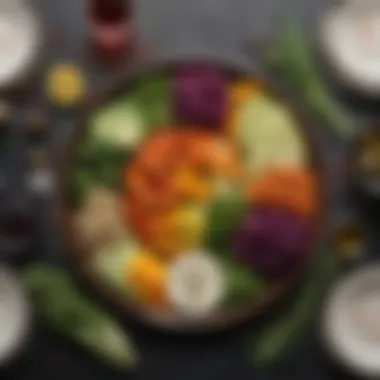

Intro
Exploring new ways to honor traditions often leads to a deeper understanding of both culture and personal identity. The idea of creating a vegan seder meal resonates especially in today's world where many individuals seek to align their eating practices with their ethical beliefs and dietary needs. This alignment does not mean letting go of cultural customs; rather, it epitomizes a modern twist on age-old practices.
This article will guide you through the intricacies of crafting a vegan seder meal by maintaining the authentic spirit of the celebration while respecting a vegan lifestyle. Through thoughtful substitutions and creative recipes, you can honor Jewish heritage without compromising dietary choices. Adopting a modern approach celebrates the environment, animals, and, of course, family.
Understanding what a traditional seder involves is integral to innovating on it.
Recipe Overview
- Name: Roasted Ratatouille Haggadah
- Servings: 6-8 portions
- Prep & Cook Time: 1 hour 30 minutes
- Difficulty: Medium
Main Ingredients
- Eggplant
- Zucchini
- Bell peppers
- Tomato sauce
- Olive oil
- Fresh herbs (thyme, basil)
- Garlic
- Onion
Adapting traditional dishes to be vegan often shifts the focus to vibrant ingredients and emphasizes plant-based flavors that can stand alone or complement a meal. Each component of a seder plate has unique meaning, which inspires us to select dishes that evoke rich symbolism even on a vegan plate. The juices and textures from roasted vegetables showcase colorful alternatives that maintain visual and cultural significance.
Step-by-Step Instructions
- Prepare the Ingredients: Start by washing and dicing the eggplant, zucchini, and bell peppers into medium-sized chunks. Chop onion and garlic finely.
- Roast the Vegetables: Preheat your oven to 425°F (220°C). Midway, toss the diced vegetables with olive oil, and spread them on a baking sheet. Sprinkle with salt and herbs.
- Cook: Roast for 25-30 minutes, stirring halfway through to ensure even cooking.
- Combine with Sauce: In a medium pan, over medium heat, sauté onion and garlic until translucent. Add crushed tomatoes; cook for about 15 minutes.
- Flavor Assembly: After veggies are done, combine them with sauce and adjust seasoning as needed.
- Serve: Transfer your roasted ratatouille to a serving bowl, garnish with fresh herbs.
For those pressed for time, prepare the ratatouille a day before Passover and store it in the refrigerator. It can be warmed up as needed and still taste fresh.
Nutritional Information
- Calories per Portion: Roughly 150 calories
- Proteins: 2 g
- Fats: 10 g
- Carbohydrates: 15 g
- Notable Nutrients:
- High in dietary fiber
- Rich in vitamins A and C
Vegetables are interesting both to the palate and the body. A meal can have beneficial effects when chosen wisely. Each vegetable adds nutritional variety, further enhancing the celebratory meal of Passover.
Quick Cooking Tips
- Use an Air Fryer: An air fryer can speed up the roasting process, enabling densely packed schedules a greater chance to focus on quality cooking.
- Maximize Multi-tasking Efficiency: Chop all vegetables in advance while sauces come to simmer. This step reduces the overall cooking time considerably.
- Explore Alternatives: If certain vegetables are not availabe, adapting this dish to puf mushroom or butternut squash can offer a similar depth while varying taste and texture.
Related Recipes & Variations
- Chickpea Salad: A refreshing sauce accompanying ratatouille complements traditional dishes like charoset.
- Vegan Matzah Ball Soup: Contains elements enjoyed in Passover many years back.
- Cooking for Variety: Incorporating beans or lentils provides additional protein options in cookery.
Thus, every Seder meal can emerge as a mixture of creative culinary instinct while honoring tradition. Planning thoughtful alternatives enhances your presentation greatly.
Adapting a vegan Seder meal does not merely switch animal products for plant-based ones. It creates an ecosystem of cultural meaning exemplified through innovative presentations. This transformation connects eater with history and ecology alike. As traditions adapt to modern sensibilities, participation becomes more dynamic and sincere.
Everybody can contribute to unique interpretations of long-held traditions, revealing how flexibility can invigorate the communion experience.
Prelims to the Vegan Seder


Creating a vegan seder meal encompasses more than just dietary choices; it seeks to bridge tradition with modern values of sustainability and compassion. Each component of the seder plate is steeped in history and meaning, which offers the opportunity to honor those roots while adjusting to a plant-based lifestyle. This section delves into the essence of the vegan seder, focusing on not just what to serve but also exploring the motives and implications behind this culinary adaptation.
Understanding the Seder
The seder is an integral aspect of Passover, involving unique rituals, texts, and food items that advocate collective remembrance and family unity. It serves as a storytelling medium about liberation, traditions, and values. Participants engage with symbolic foods like matzah and bitter herbs, using the meal as a means to reclaim their identity and explore complex topics surrounding inequality and heritage. With these cultural dimensions, a vegan seder can reflect a progressive stance—upholding not just Jewish traditions but also contemporary ethical consideration regarding food sourcing and animal welfare.
The Significance of a Vegan Approach
Adopting a vegan approach in crafting a seder meal aligns with responsible decision making in our current context. As debates surrounding climate change and animal rights grow, shifting toward plant-based diets emerges as a crucial response. By choosing to veganize traditional foods, individuals advocate for a compassionate lifestyle that transcends dietary preferences. Moreover, this transformation allows relevant connections to the narrative of freedom, shedding light on the ethical implications of our eating habits.
In practical terms, crafting a vegan seder does not diminish the authenticity of the experience; instead, it enhances it. As families are faced with diverse dietary needs and ethical beliefs, a vegan seder creates an inclusive environment. By fostering meaningful conversations that resonate with both historical narratives and present-day concerns, the vegan seder cultivates deeper connections that honor Jewish heritage while promoting modern values reflecting care and consideration.
Traditional Seder Components Reimagined
The significance of reimagining traditional Seder components cannot be overstated. This modern approach aims to honor age-old customs while accommodating contemporary dietary needs. A vegan Seder meal aligns with the values of empathy and respect for all living beings. It challenges the notion of tradition, prompting individuals to explore how cultural practices can adapt without losing their meaningful context. This adaptability grants people a chance to engage with their heritage positively, promoting inclusivity and broader accessibility.
Matzah: The Unleavened Bread
Matzah serves as a foundational aspect of the Seder plate, representing the haste with which the Israelites left Egypt. In a vegan context, the principle of the ingredient remains unchanged, even if the method of preparation might adapt slightly. Traditional matzah is often simply flour and water. Vegan options can maintain this purity, albeit with variations like whole wheat or spelt flour to enhance nutrition and flavor.
The inclusion of baked matzah adds a discussion on sourcing. Opting for organic flours is advisable. Such choices elevate your meal with ethical meanning. This gives guests not just food, but a story to savor in every bite.
Maror: The Bitter Herbs
Maror signifies the bitterness of oppression and suffering experienced by the Jewish people. Often, horseradish is the traditional component for maror. However, various edible bitter options may be explored. Endives and arugula provide different textures while maintaining the vital element of bitterness. These alternatives can enhance the sensory experience as one takes in the flavor associated with meaning.
Customizing maror does not alter its representation; rather, it encourages thoughtful reflection on the burdens we still share today. Bringing bitterness forward in various formats can lead to deeper discussion at your Seder table.
Charoset: The Sweet Mixture
Charoset is a sweet mixture usually made from apples, nuts, and wine or cider. This symbol of mortar used by the Jewish slaves gives a lens into hope and sweetness amidst hardship. Adapting charoset for a vegan meal is n the scope of creativity uses plentiful fresh fruit enhances its appeal. Typical combinations might include pears, figs, and perhaps cranberries, offering unique blends of textures and flavors.
Another element worth considering is reducing refined sugars or replacing with natural sweeteners. Solutions like maple syrup or agave nectar can keep the infusion rich while meeting vegan standards. Creativity shines in harmonizing mundane life with festival whimsy through thoughtfully made charoset.
Karpas: The Vegetable Element
Traditionally represented by parsley or celery, Karpas brings additional symbolism to the plate. It is a reminder of new beginnings inspired by spring. When transitioning to a vegan table, choices expand beyond typical options. Root vegetables like radishes can provide exciting colors. Alternately, the crispness of cucumbers is refreshing throughout the Seder and can represent renewal as they signal the wakefulness of life.
Though sourced naturally, being forumulated interesting mutations keeps the legacy fresh. Make Karpas a vegetable showcase by surpassing merely acceptable ingredients, increasing a vegan Seder's visual dignity. Save substances like brightness to uphold prominence for each component.
Every component of the Seder holds immense significance. The goal here is to rethink, recreate, and reconnect with that meaning without replicating old flaws.
Vegan Substitutions for Seder Plates
Crafting a vegan seder plate is a thoughtful way to honor tradition while aligning with modern dietary practices. The significance lies not just in abstaining from animal products, but also in redefining how we engage with the rituals. A vegan seder allows for inclusivity, ensuring that all participants can partake meaningfully.
Replacing Traditional Ingredients
To create a vegan seder meal, you must first consider what to replace. Certain traditional items are integral to the seder plate. These ingredients often hold deep meaning. For instance, when substituting lamb shank bone, you can use roasted beet. It symbolizes the blood of the Passover sacrifice. Their deep red color makes it a fitting choice.
For Charoset, typically made with honey and various chopped fruits, opt for agave syrup or maple syrup instead. They offer a similar sweetness without the use of animal products. Furthermore, the incorporation of nuts and apples can enhance the flavor and complement the dish perfectly.
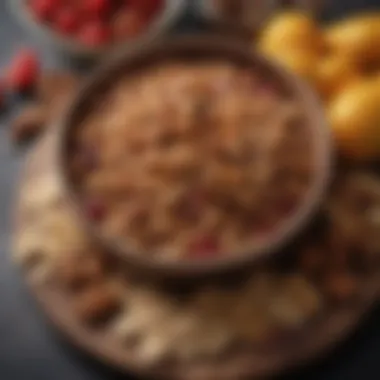
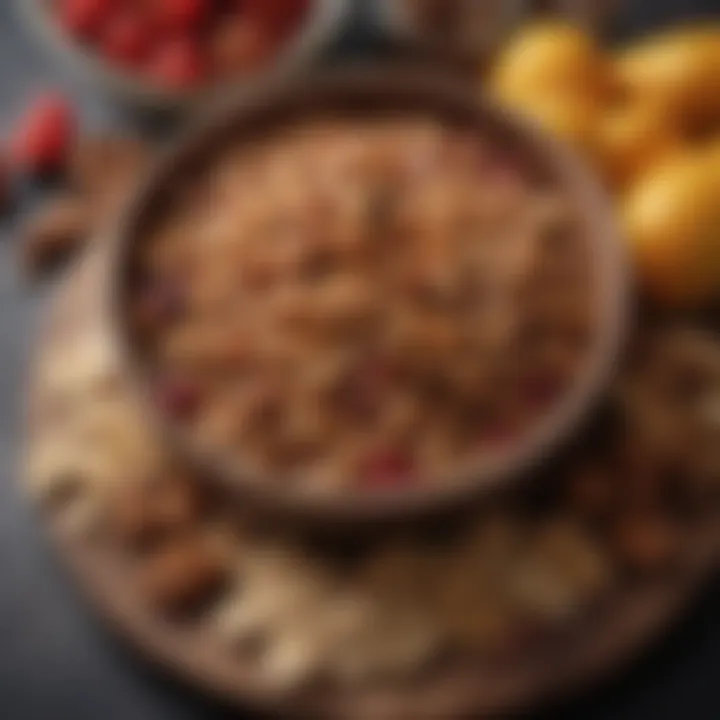
Bitter herbs are also present on the plate. Usually, horseradish is the choice. However, you can replace it with a mix of dandelion greens and radish, providing a rich, bitter flavor while remaining true to the new formulation.
Avocado can stand in for egg in certain dishes, akin to how one might prepare Mediterranean spreads. Remember, how these replacements are assembled tells a story of adaptation and recognition of changing times but honoring historic roots.
Innovative Vegan Recipes
There is a wealth of creativity waiting to be explored in vegan recipes for a seder plate. Consider these innovative ideas:
- Vegan Matzah Balls: Traditional matzah balls can be made using ground matzah paired with tofu and spices. It's a delightful springboard into new territory.
- Sweet and Tangy Charoset: For a fresh twist, include figs and dates with the traditional apples. A dash of cinnamon can elevate the mixture to new flavor profiles.
- Herbed Vegetable Karpas: Instead of just boiling potatoes, create a mixture of roasted carrots, radishes, and turnips with herbs going under the name karpas. The presentation itself makes it vibrant and festive.
One of the most impactful ways to engage with the seder tradition is through thoughtful inclusivity in recipe formulation, showcasing how canembrace dietary preferences without compromising on meaning.
The goal of these substitutions and innovative recipes is not only about honoring dietary restrictions but also about practicing a form of culinary mindfulness that connects one to the roots of their heritage. Thus, preserving the spirit of the ceremony while uplifting modern values.
Sample Vegan Seder Menu
Creating a vegan seder menu is not just about substituting ingredients; it's about enriching the celebration while keeping in touch with longstanding customs. A carefully planned menu can honor tradition, highlight plant-based options, and meet the needs of all attendees. This section presents an array of ideas crafted with intention and reverence towards the meaningful aspects of Passover.
Appetizers and Starters
Beginning the seder with appetizers sets the stage for the evening's meal, offering flavors that gratify without overshadowing the main events. Consider starters like cherry tomato salad tossed with herbs, roasted asparagus with a lemon aioli, or asparagus wrapped in vegan bacon. Each o f these provocatively highlights colors and scents, ensuring an inviting table setup. More traditional options can be included too, like matzah ball soup, made with chickpea matzahs, packed in vegetable broth laced with pureed greens for depth.
- Stuffed mushrooms with quinoa and spices can be a delightful choice.
- Vegan charcuterie boards with hummus, olives, nuts, and fresh fruits create a superb mix of textures.
A dedicated starter plate signifies a comfort in showcasing flavors while sustaining significant garnishes for individual preferences.
Main Course Ideas
The main course is the highlight and heart of the seder meal. There is ample room to be inventive and respectful of staple choices. Roasted vegetables can take center state, accompanying combinations like sweet potatoes, carrots, and beets, mingling within aromatic herbs. Vegan gefilte fish, made with chickpeas and blended spices, can reflect the traditional preparation while aligning with plant-based principles. Lengthy engagements in flavors should appeal not just via taste but also nutritional enhancement.
Besides that, Lentil shepherd's pie, topped with creamy mashed potatoes or rooted in such classics, can provide a generous third-course establishment. Themes emerged such as family favorites and a blend of heritage among innovative offerings.
Vegetarian moussaka could also be an impressive main dish. Choosing dishes that allow multiple servings helps relieve additional stress with tight schedules.
Dessert Options
Ending the meal with dessert can elegantly tie in with the spirit of the occasion. Options should embody sweetness and tradition. Recipes can include vegan chocolate mousse made with silken tofu and dark cocoa. Alternatively, a refreshing coconut sorbet could cleanse the palate while tying in themes from the various courses.
Traditional fare should not be a forgotten element too, as coconut macaroons made with almond flour bring richness in taste and kind connection to Jewish sweet dishes. More elaborately crafted could be mini-tarts filled with fruit preserve or vegan cheesecake using cashews for a clean finish.
Provide more than dessert; offer experiences that inspire conversation about heritage.
Tips for Streamlining the Preparation Process
The preparation for a vegan Seder meal can be daunting. However, employing effective techniques can make this process less stressful. Optimization during the preparation phases not only saves time but also improves the overall experience for the hosts and guests alike. Focusing on specific elements such as time management and batch cooking are essential strategies for anyone looking to master this culinary adventure with efficiency in mind.
Time Management Techniques
Managing your time effectively is paramount when organizing a vegan Seder meal. Planning ahead allows for a smooth preparation experience. Start with creating a menu well in advance. This should include appetizers, main dishes, side salads, and desserts." Each dish can then be assigned a expected preparation time. Make a detailed shopping list based on your chosen recipes. It minimizes repeated trips to the store and prevents forgotten ingredients.
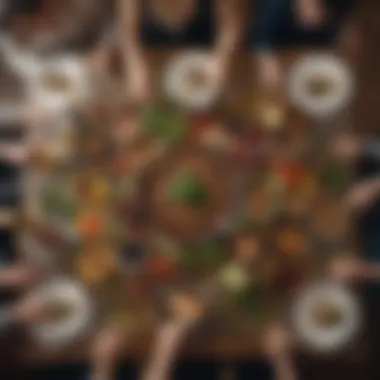
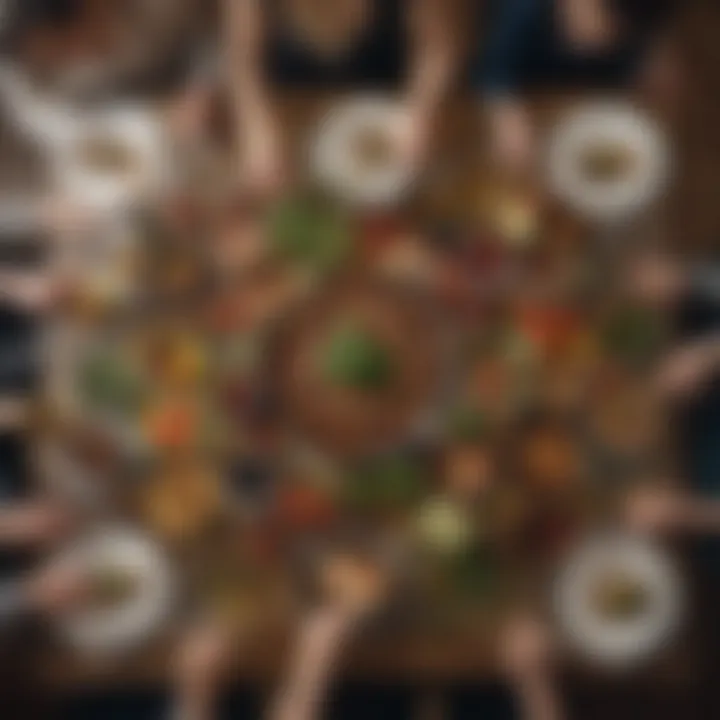
Another useful technique is to organize your cooking tasks. Divide the tasks into smaller, manageable portions. Prioritize the ingredients that require longer cooking times. For example, start by preparing items like maror or roasted vegetables beforehand, as they can stay fresh in the refrigerator.
It's also wise to tackle simpler components of the menu midweek before the holiday. Items such as charoset can be made days in advance. This preparation core principles can lead once a cohesive narrative clean and allows more time during the busy day of Seder itself.
Batch Cooking Strategies
Batch cooking can significantly lighten the workload on the day of the Seder. This approach involves preparing meals in larger quantities and then using portions for different meals throughout the week or s0pecial festival. Choose vegitables and dishes that can be hypo-allergenic in batches.
Some dishes that translate well into batch cooking include soup or stews, sauces and dips like hummus or tahini. You can also roast a variety of vegetables that can be added to multiple dishes, including the main course and salad.
Batch cooking enables you to maximize flavors and offers the added benefit of simplifying your cooking process.
Making use of freezer storage for prepared meals can also be beneficial. Stews that freeze well can be reheated with ease. This not only saves time, but also allows for creativity on days leading up to the Seder.
These methods help preserve the spirit of Seder while allowing it to integrate into modern, busy lives. Overall tiny adjustments in time planning can truly revive not énd the meal kreifs but your personal experience, honor the significant traditions involved.
Preserving the Spirit of the Seder
Preserving the essence of the Seder is fundamental to creating a meaningful vegan meal. The Seder is about more than just food; it’s a time for storytelling, values, and memories. As traditions adapt, it is vital to retain the rituals that make this occasion unique. In a modern context, this includes acknowledging dietary restrictions while connecting deeply to history.
Incorporating vegan ingredients can enhance not only dietary inclusivity but also respect ancient customs. A Seder without traditional staples like matzah might seem unrecognizable, but through mindful choices and substitutions, it can still embrace its core significances. Each component, from the Seder plate to the rituals observed, should reflect the values of dignity, respect for life, and environmental awareness that align with vegan principles.
Ultimately, creating a vegan Seder connects contemporary practices with ancestral legacies, bridging gaps while respecting personal beliefs.
Incorporating Tradition into a Vegan Context
Adapting Seder elements to a vegan diet does not mean that tradition must be forfeited. Indeed, many traditional ingredients offer great flexibility when it comes to vegan alternatives. For instance, the classic matzah can be sourced vegan-friendly—or individuals can even opt to create similar unleavened breads from alternative grains.
Popular vegan substitutions include:
- Matzo Brei: Use cashew or flax-based cream to mimic traditional taste.
- Charoset: Traditional fruits can be replaced with apples and walnuts without loss of meaning.
- Bitter Herbs: Select kale or dandelion greens, ensuring the symbolic meaning, of bitterness, remains at the heart of the meal.
It is beneficial to share and explain these substitutions to enhance the experience for guests. Engaging conversations can arise when members reflect on their significance in both a sacred and modern context.
Engaging Family and Friends
A successful vegan Seder also hinges on the communal spirit of Passover. Fully engaging family and friends can help bridge generational gaps, showing that even a modern approach can honor shared history. To create a nurturing environment during the Seder:
- Organize interactive discussions. Topics could cover the meaning behind the Seder elements instead of following a rote script.
- Invite guests to share their stories related to past Seders—encouraging reflection on how family histories shape current perspectives.
- Create an inviting atmosphere with visuals and decorations that resonate with the beauty of tradition, reclaiming Jewish heritage through modern yet respectful furnishings.
In summary, incorporating a vegan approach to the Seder does not dilute tradition but enriches it. Engaging conversations excite thought-provoking discussions among diners and cultivate a memorable experience steeped in the significance of shared cultural values.
Ending: Celebrating Inclusivity in Tradition
Crafting a vegan Seder meal embraces a thriving dialogue around modern dietary practices while honoring time-honored traditions. The essence of this approach underscores a significant shift towards inclusivity. By accommodating varied dietary lifestyles, we create a more welcoming space for all, especially in a communal setting such as the Seder. This inclusion allows each participant to engage in connections that convey empathy and respect for individual choices.
Embracing Change in Cultural Practices
Cultural adaptability plays a crucial role in shaping celebrations in contemporary society. When traditions are infused with modern principles, they gain new life. A vegan Seder aligns seamlessly with the principles of compassion and care fundamental to Jewish teachings. This adaptation also corresponds to the increasing needs for sustainability and health-conscious lifestyles prevalent today.
Additionally, exploring plant-based options is not solely about food substitutions; it is about excavating the ethics behind our choices. The ritual life can incorporate modern values without losing inherent meaning. This practice opens realms for discussion and reflection within family gatherings.
In summation, the melding of the past with the present allows the Seder to remain relevant in our lives. This transformative practice can be a catalyst for wider acceptance of diverse practices among various demographics, thus enriching the cultural tapestry we continuously weave.
“Tradition is not the worship of ashes, but the preservation of fire.” – Gabriel Marcel
As practitioners venture into reconstructing their Seder plates, they affirm their bonding with heritage while actively participating in a community approach that appreciates differences. Embracing change does not necessitate complete abandonment of former ways. Instead, it encourages the growth of new, rich veins of practice that cater to inclusivity without detracting from genuine tradition.







